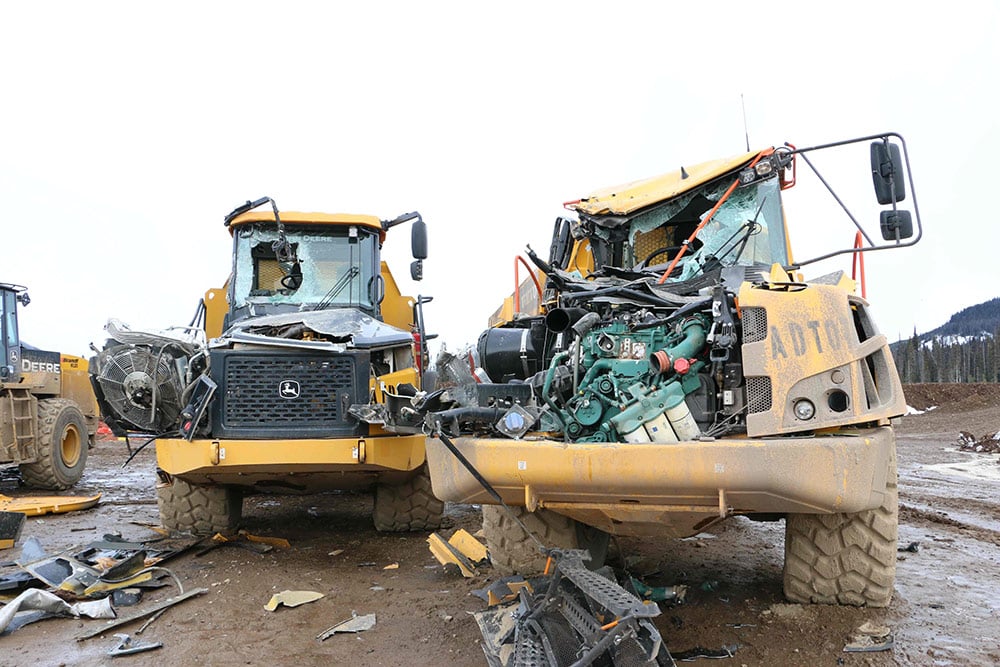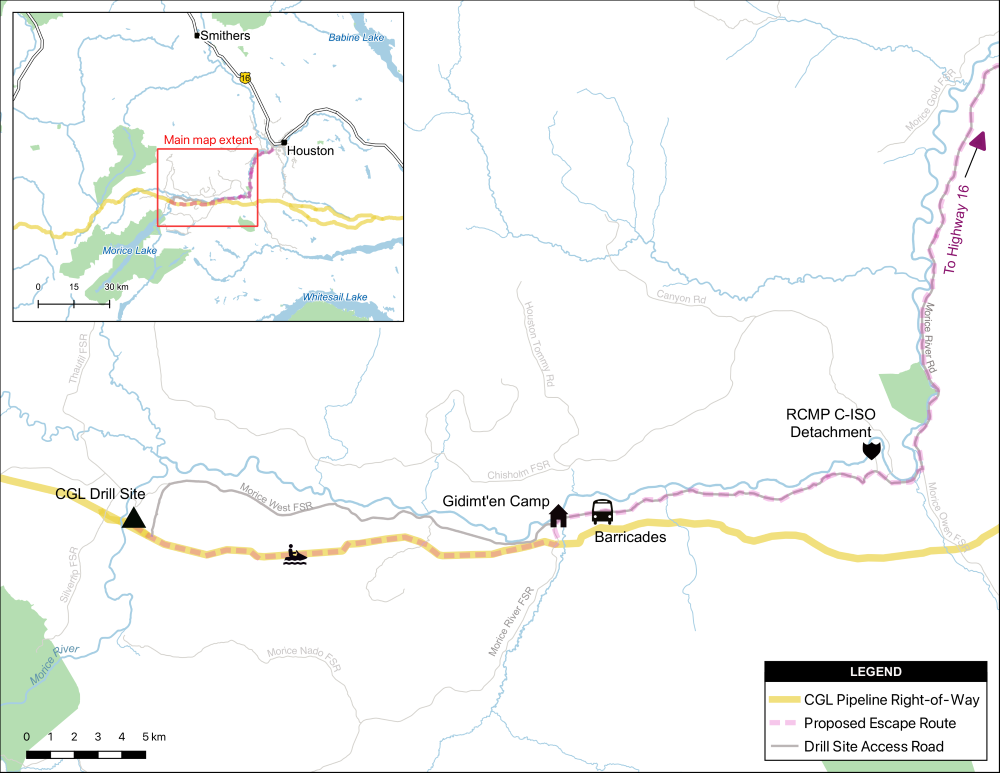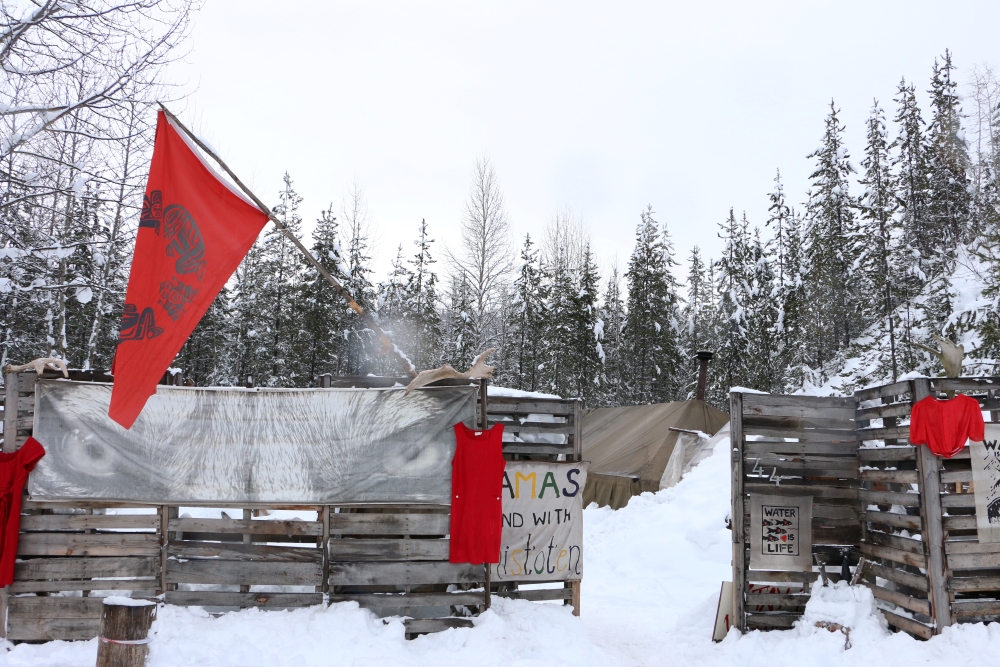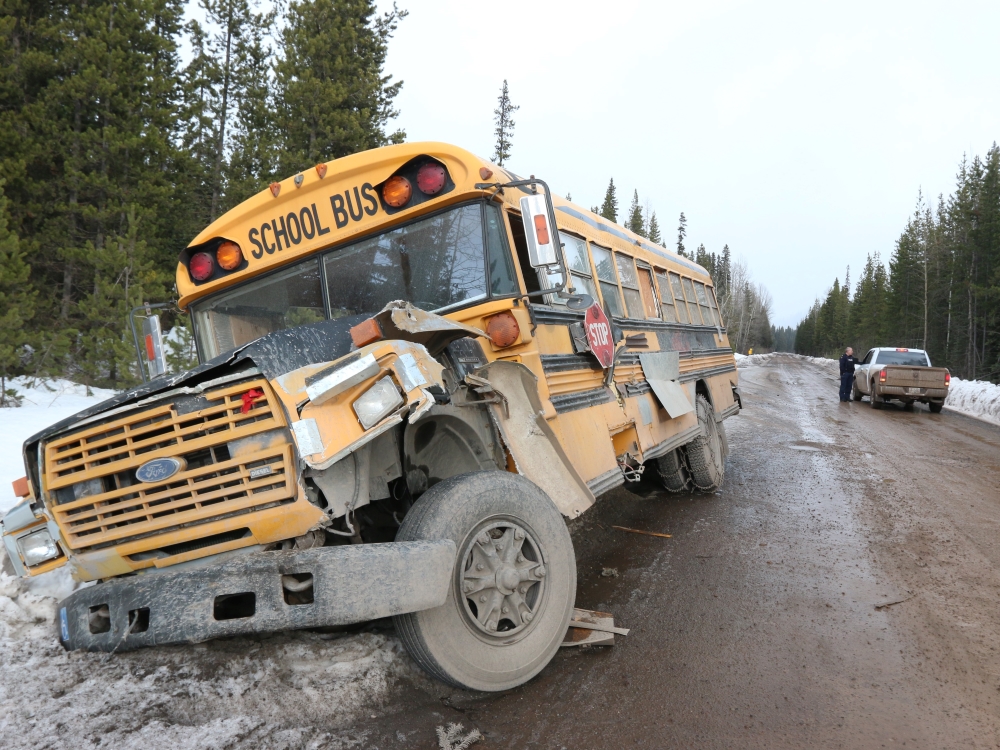More than a year after an alleged attack at a Coastal GasLink pipeline worksite, the RCMP has provided an update about how it believes more than a dozen assailants fled a remote area in northwest B.C. without being caught.
Some of those details — such as the location where police encountered the suspects — directly contradict information released in the days following the Feb. 17, 2022, incident. But RCMP say they are standing by their most recent version of events, declining to provide an explanation for the changes or a followup interview.
“What I can say is that the information that was released previously was believed to be accurate at the time,” RCMP senior media relations officer Kris Clark said, acknowledging the discrepancy. “As we now have a more fulsome accounting of the events, I can confirm that the information Chief Supt. John Brewer provided is accurate.”
It was shortly after midnight on Feb. 17 when RCMP say they received the call from Coastal GasLink’s private security reporting that assailants wearing white camouflage had swung axes, fired flare guns and damaged vehicles, forcing workers to flee the site where the company was preparing to drill under the Morice River.
Once workers had fled, police say attackers commandeered company equipment and used it to destroy mobile buildings and heavy machinery at the site, causing millions of dollars in damage. Coastal GasLink reported that roughly nine employees were threatened during the incident. One officer was injured, according to RCMP.
In the aftermath, the force said it was sending 40 investigators to the area. But it has provided few details on that investigation.

The Morice River, known to the Wet’suwet’en as Wedzin Kwa, is at the heart of a years-long dispute over pipelines through the nation’s traditional territory.
The drill site is 65 kilometres southwest of Houston, B.C., located down a spur of the Morice Forest Service Road. It is bordered by the river to the west, the cleared pipeline right-of-way to the east and dense forest to the south. To the north is the Morice road, the only access road into the area. The remote resource road has been the site of several blockades and high-profile police actions in recent years.
Since the first of those police actions in January 2019, RCMP has maintained a constant presence in the area. Its Community-Industry Response Group, a unit created in 2017 to police pipeline and other resource-industry conflicts, established a detachment, the Community-Industry Safety Office, about 30 kilometres down the Morice road in early 2019.
For months following the Feb. 17 incident, C-IRG officers began entering a camp established by Wet’suwet’en land defenders, known as Gidimt’en Checkpoint, multiple times a day and often at night, saying they had found a link between the camp and the drill site attack. RCMP previously declined to provide details of the connection.
The Tyee followed the story closely, travelling to the remote work site and interviewing RCMP Chief Supt. Warren in the days following the incident. Multiple requests for an update or followup interview were declined in the year that followed.
In April, after CBC published an article blaming anarchists for the attack, The Tyee repeated its request. The RCMP agreed to provide Chief Supt. John Brewer, gold commander of the C-IRG unit, for a 15-minute interview.
According to Brewer, police now believe the suspects fled the area on snowmobiles, ditching them at Gidimt’en Checkpoint before driving out the Morice road undetected. It’s the first time RCMP have directly implicated the camp in the alleged attack.
Gidimt’en Checkpoint representatives did not respond to a request for comment before deadline.

According to Brewer, once RCMP received the call shortly after midnight, officers responded from the Community-Industry Safety Office, or C-ISO. Although RCMP agreed to close the remote detachment as Wet’suwet’en leadership entered talks with the provincial and federal governments in February 2020, Brown and Brewer discussed reopening it in November 2021, according to internal communications obtained through freedom of information laws.
On the night of the attack, officers had travelled about a dozen kilometres from the C-ISO detachment when they encountered fallen trees and a school bus barricading the Morice road near kilometre 43, Brewer said in his recent interview. They didn’t encounter any people, he confirmed.
After clearing the obstructions, officers continued to the drill site, roughly 20 kilometres father down the Morice road.
While assessing the scene, police spotted people upslope from the drill site, about 150 or 200 metres away, Brewer said. The suspects were wearing white camouflage and “kind of gesturing,” he added. While some officers stayed behind to secure the scene, a small group gave chase.
“They start running away and our members start to pursue right where they were, and we immediately encounter what and I call ‘man traps,’ because that’s the definition, a number of boards laying on the ground covered a bit with snow and debris with nails sticking up,” Brewer said.
The commander ordered the pursuit stopped, deciding it was too dangerous to proceed after one officer injured his foot on a nail, he said.
What police didn’t realize, Brewer told The Tyee, was that the suspects had snowmobiles stashed along the pipeline route just east of the drill site. They used the sleds to travel 20 kilometres east along the pipeline right-of-way, which intersects a branch of the Morice road near Gidimt’en Checkpoint.
“We had no idea at the time that they had the means to get that far away that fast,” Brewer added.
When asked why police didn’t hear the departing snowmobiles that night, Brewer said commotion at the site of the attack would have made it difficult.
“You have to appreciate, it’s not a silent scene. We have people there. There’s vehicles running. People are yelling and that, because we’ve got a number of CGL workers traumatized. We’re now searching through debris to see if we’ve got people injured in the debris,” he said.
In the light of day, police followed sled tracks “to the vicinity where the right-of-way goes down towards the camp,” Brewer said. At the camp, he said they found snowmobiles believed to be the ones driven by the suspects.
“I can’t say for sure the sleds that were there the next day were the same sleds. We didn’t get a view of them,” he added. RCMP didn’t respond to followup questions about whether they inspected the sleds or spoke to camp occupants, either on the day of the attack or in the days that followed.
Once at the camp, Brewer said police believe the suspects swapped the snowmobiles for on-road vehicles and drove out the Morice road to join Highway 16 just west of Houston.
In a post the day after the attack, Coastal GasLink underscored the remoteness of the area, saying, “It’s unknown where the attackers went after fleeing the scene. The RCMP maintained a checkpoint on the road following the attack.”
But Brewer said no one was stationed along the Morice road or at the highway turnoff that night, as officers focused on responding to the unfolding events at the drill site.
“We had all available resources heading up to the attack site because, remember, it was ongoing,” he said.
RCMP declined to answer whether it was still dark, or getting light by the time officers reached the drill site and spotted the suspects, citing the ongoing investigation.

Brewer’s version of events differed from those shared by Brown in the days following the February 2022 attack. Most significantly, the location where RCMP officers engaged with the suspects has shifted by 20 kilometres — from near Gidimt’en Checkpoint to the drill site itself.
When The Tyee spoke with Chief Supt. Warren Brown on Feb. 22, 2022, he provided a detailed description of how three on-call RCMP officers responding from Houston engaged in a tense exchange with suspects at kilometre 43, about a kilometre before the camp, as they attempted to remove obstructions on the road.
“The assailants were nearby in the bush,” Brown said. “They started to throw sticks that were covered in some sort of oil, gas, tar, kerosene — some kind of material that allowed it to light on fire. These were being thrown towards the police. There were some kind of gas canisters, too, some kind of small little gas canisters that would create smoke in the air.”
It was here, Brown said, that an RCMP officer stepped on a board with nails through it, injuring his foot. Police backed off the chase and called for more officers, which “didn’t come for hours,” Brown said.
In a news release issued the day of the attack, RCMP said officers didn’t find anyone once they arrived at the drill site. “Police did not encounter any further blockades or protestors as they made their way to the drill pad nor did they locate anyone at the site,” the statement said.
Five days later, Brown said investigators had thoroughly combed the bush surrounding the drill site and uncovered “a significant amount of evidence,” including snowshoes. At the time, he said police believed vehicles had dropped the assailants “further up” the Morice road and they had snowshoed into the site. “They would have likely left the same way,” Brown added.
In a draft news release shared with B.C.’s Public Safety Ministry hours after the Feb. 17 attack, Coastal GasLink estimated the number of assailants could be as high as 40. It amended that number in a statement released later the same day, saying “approximately 20 masked and violent attackers” had approached workers in the early hours.
Brewer similarly estimated between 15 and 25 people were involved, but added, “that’s not just the attackers, that’s supporters… people that would either have blocked the road beforehand or provided a means to get them out of the area after the fact.”
He said RCMP are currently looking at about half a dozen suspects but declined to say whether anyone has been brought in for questioning, saying the investigation is ongoing. He said the force continues to followup on evidence such as images of partially covered faces, voice recognition and DNA recovered at the scene.
He couldn’t comment on when RCMP might make arrests.
RCMP have always distinguished the Feb. 17 attack from peaceful protests on the Morice road. Following the incident, Brown said that investigators were looking at people from outside the area as suspects.
When asked about his comments to the CBC that anarchists had infiltrated the camp, highjacking the local movement, Brewer said that he’s seen the occupation evolve over the past few years.
“The people up there have changed,” he said. “There’s certainly far fewer locals, certainly far fewer Wet’suwet’en people, and we are seeing smaller numbers but a more radical element.” ![]()
Read more: Indigenous, Energy, Rights + Justice, Environment

















Tyee Commenting Guidelines
Comments that violate guidelines risk being deleted, and violations may result in a temporary or permanent user ban. Maintain the spirit of good conversation to stay in the discussion and be patient with moderators. Comments are reviewed regularly but not in real time.
Do:
Do not: